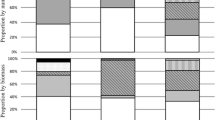Abstract
Many waders and ducks rely exclusively on invertebrates for their food and can deplete populations of these invertebrates. The mudsnail Hydrobia ulvae and the shelduck Tadorna tadorna are both widespread and abundant and in previous studies H. ulvae has been identified as the main food source for shelduck. The objective of the study was to quantify the predation of shelduck of H. ulvae on an intertidal mud flat in north Wales in order to estimate the contribution of shelduck predation to H. ulvae mortality and to estimate the importance of H. ulvae in the diet of shelduck. The contribution of shelduck towards the observed mortality was estimated from the number of H. ulvae per dropping, the number of droppings produced per hour and the number of shelduck found at the study site. Shelduck predation hardly made a contribution to the observed mortality of H. ulvae. Examination of the energetic requirements of shelduck shows that H. ulvae cannot be a significant part of the diet. In conclusion, the predation of shelduck on H. ulvae was irrelevant for both the population dynamics of the mud snail and for the energy requirements of shelduck in the study area.


Similar content being viewed by others
References
Bachelet G, Yacine-Kassab M (1987) Intégration de la phase post-recrutée dans la dynamique des populations du gastéropode intertidal Hydrobia ulvae (Pennant). J Exp Mar Biol Ecol 111:37–60. doi:10.1016/0022-0981(87)90019-0
Berry AJ (1988) Annual cycle in Retusa obtusa (Montagu) (Gastropoda, Ophisthobranchia) of reproduction, growth and predation upon Hydrobia ulvae (Pennant). J Exp Mar Biol Ecol 117:197–209. doi:10.1016/0022-0981(88)90057-3
Cadée GC (1988) Levende wadslakjes in bergeend faeces. Corr Blad Malac 243:443–444
Cadée GC (1994) Eider, shelduck, and other predators, the main producers of shell fragments in the Wadden Sea: palaeoecological implications. Palaeontology 37:181–202
Campbell JW (1947) The food of some British Wildfowl. Ibis 89:429–432. doi:10.1111/j.1474-919X.1947.tb04360.x
Collier MP, Banks AN, Austin GE, Girling T, Hearn RD, Musgrove AJ (2005) The Wetland Bird Survey 2003/2004: Wildfowl and Wader counts, BTO/WWT/RSPB/JNCC, Thetford
Dekinga A, Piersma T (1993) Reconstructing diet composition on the basis of faeces in a mollusc-eating wader, the knot Calidris canutus. Bird Study 40:144–156
Evans PR, Pienkowski MW (1982) Behaviour of shelducks Tadorna tadorna in a winter flock: does regulation occur? J Anim Ecol 51:241–262. doi:10.2307/4323
Evans PR, Herdson DM, Knights PJ, Pienkowski MW (1979) Short-term effects of reclamation of part of Seal Sands, Teesmouth, on wintering waders and Shelduck. Oecologia 41:183–206. doi:10.1007/BF00345002
Guillemain M, Fritz H, Duncan P (2002) The importance of protected areas as nocturnal feeding grounds for dabbling ducks wintering in western France. Biol Conserv 103:183–198. doi:10.1016/S0006-3207(01)00120-3
Hayward PJ, Ryland JS (1996) Handbook of the marine fauna of North-West Europe. Oxford University Press, Oxford
Hiddink JG (2003) Modelling the adaptive value of intertidal migration and nursery use in the bivalve Macoma balthica. Mar Ecol Prog Ser 252:173–185. doi:10.3354/meps252173
Holme NA, McIntyre AD (1984) Methods for the study of marine benthos. Blackwell Scientific Publications, Oxford
Jennings S, Kaiser MJ, Reynolds JD (2001) Marine fisheries ecology. Blackwell Publishing, Oxford
Jensen KT, Mouritsen KN (1992) Mass mortality in two common soft-bottom invertebrates, Hydrobia ulvae and Corophium volutator—the possible role of trematodes. Helgol Meersunters 46:329–339. doi:10.1007/BF02367103
Mendonça VM, Raffaelli DG, Boyle PR (2007) Interactions between shorebirds and benthic invertebrates at Culbin sands lagoon, NE Scotland: Effects of avian predation on their prey community density and structure. Sci Mar 71:579–591
Mitchell DW, Grubaugh JW (2005) Impacts of shore birds on macroinvertebrates in the lower Mississippi Alluvial Valley. Am Midl Nat 154:188–200. doi:10.1674/0003-0031(2005)154[0188:IOSOMI]2.0.CO;2
Olney PJS (1965) Food and feeding habits of the shelduck Tadorna tadorna. Ibis 107:527–532. doi:10.1111/j.1474-919X.1965.tb07335.x
Piersma T, Hoekstra R, Dekinga A, Koolhaas A, Wolf P, Battley P, Wiersma P (1993) Scale and intensity of intertidal habitat use by knots Calidris canutus in the western Wadden sea in relation to food, friends and foes. Neth J Sea Res 31:331–357. doi:10.1016/0077-7579(93)90052-T
Snow D, Perrins C (1998) The Birds of the Western Palearctic, Concise Edition. Oxford University Press, New York
Sola JC (1996) Population dynamics, reproduction, growth, and secondary production of the mud-snail Hydrobia ulvae (Pennant). J Exp Mar Biol Ecol 205:49–62. doi:10.1016/S0022-0981(96)02597-X
Sutherland WJ (1982) Spatial variation in the predation of cockles by oystercatchers at Traeth Melynog, Anglesey. II. The pattern of mortality. J Anim Ecol 51:491–500. doi:10.2307/3979
Van Gils JA, De Rooij SR, Van Belle J, Van Der Meer J, Dekinga T, Drent R (2005) Digestive bottleneck affects foraging decisions in red knots Calidris canutus. I. Prey choice. J Anim Ecol 74:105–119. doi:10.1111/j.1365-2656.2004.00903.x
Young CM (1970) Territoriality in the common shelduck Tadorna tadorna. Ibis 112:330–335. doi:10.1111/j.1474-919X.1970.tb00110.x
Zwarts L, Blomert AM (1992) Why knot Calidris canutus take medium-sized Macoma balthica when six prey species are available. Mar Ecol Prog Ser 83:113–128. doi:10.3354/meps083113
Acknowledgements
The authors would like to thank Dr. Will Sandison of the Countryside Council for Wales for granting permission to work at Traeth Melynog. We would like to thank the reviewers of this paper for comments which improved this paper.
Author information
Authors and Affiliations
Corresponding author
Rights and permissions
About this article
Cite this article
Anders, N.R., Churchyard, T. & Hiddink, J.G. Predation of the shelduck Tadorna tadorna on the mud snail Hydrobia ulvae . Aquat Ecol 43, 1193–1199 (2009). https://doi.org/10.1007/s10452-008-9216-5
Received:
Accepted:
Published:
Issue Date:
DOI: https://doi.org/10.1007/s10452-008-9216-5




